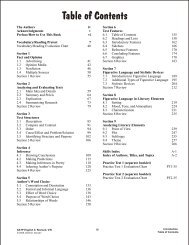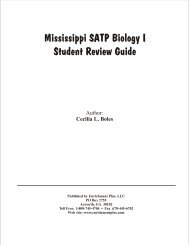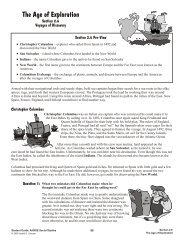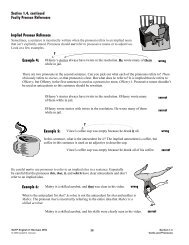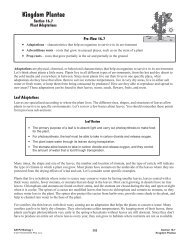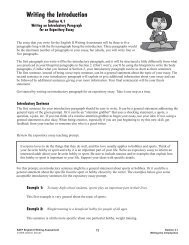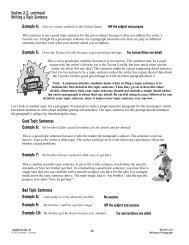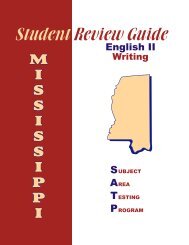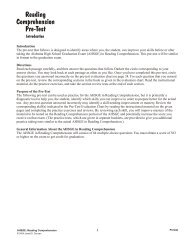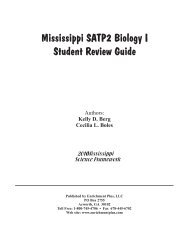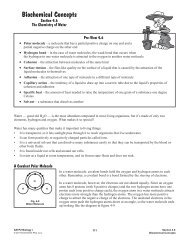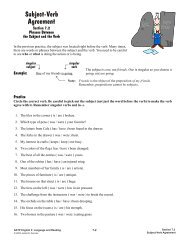Mississippi SATP2 English II : Multiple Choice ... - Enrichment Plus
Mississippi SATP2 English II : Multiple Choice ... - Enrichment Plus
Mississippi SATP2 English II : Multiple Choice ... - Enrichment Plus
Create successful ePaper yourself
Turn your PDF publications into a flip-book with our unique Google optimized e-Paper software.
Table of ContentsThe Authors iv Section 6Acknowledgments v Text FeaturesPreface/How to Use This Book vi 6.1 Table of Contents 1556.2 Headings and Lists 158Vocabulary/Reading Pretest 7 6.3 Introductory Features 162Vocabulary/Reading Evaluation Chart 40 6.4 Sidebars 1666.5 Reference Features 170Section 1 6.6 Concluding Features 174Fact and Opinion 6.7 Graphics 1781.1 Advertising 41 Section 6 Review 1831.2 Opinion Media 431.3 Nonfiction 46 Section 71.4 <strong>Multiple</strong> Sources 50 Figurative Language and Stylistic DevicesSection 1 Review 55 7.1 Introduction to Figurative Language 1897.2 Additional Types of Figurative Language 195Section 2 7.3 Stylistic Devices 204Analyzing and Evaluating Texts Section 7 Review 2122.1 Main Idea and Details 592.2 Summary and Précis 64 Section 82.3 Explication 67 Figurative Language in Literary Elements2.4 Summarizing Research 73 8.1 Setting 219Section 2 Review 79 8.2 Mood, Tone, and Atmosphere 2248.3 Characterization 231Section 3 Section 8 Review 235Text Structures3.1 Description 85 Section 93.2 Compare and Contrast 91 Analyzing Literary Elements3.3 Order 94 9.1 Point of View 2393.4 Cause/Effect and Problem/Solution 99 9.2 Plot 2473.5 Identifying Structure and Purpose 102 9.3 Soliloquy 255Section 3 Review 106 9.4 Theme 257Section 9 Review 266Section 4Inference Skills Index A-14.1 Drawing Conclusions 109 Index of Authors, Titles, and Topics A-24.2 Making Predictions 1154.3 Making Inferences in Poetry 118 Practice Test 1 (separate booklet)4.4 Inferring Author’s Purpose 120 Practice Test 1 Evaluation Chart PT1-35Section 4 Review 125Practice Test 2 (separate booklet)Section 5 Practice Test 2 Evaluation Chart PT2-35Author’s Word <strong>Choice</strong>5.1 Connotation and Denotation 1335.2 Formal and Informal Language 1365.3 Effect of Word <strong>Choice</strong> 1385.4 Purpose of Word <strong>Choice</strong> 1435.5 Relationships of Words 146Section 5 Review 150<strong>SATP2</strong> <strong>English</strong> <strong>II</strong>: V/R© 2012 <strong>Enrichment</strong> <strong>Plus</strong>, LLCiiiIntroductionTable of Contents
Framework Competency(Max. DOK)TextSection(s)Pre-Test(DOK)PracticeTest 1(DOK)PracticeTest 2(DOK)2d (3) The student will analyze orevaluate texts to synthesisresponses for summary, précis,explication, etc.Section 26(2), 19(3), 37(2)6(2), 22(2), 26(2)31(2)10(2), 12(2), 20(2)22(3)2e (3) The student will analyze . . .literary elements in multiple textsfrom a variety of genres and mediafor their effect on meaning . . .Sections 7 and 913(2), 22(3), 26(3)29(2), 33(3)1(2), 5(3), 15(3)19(2), 24(2)2(2), 7(2), 14(2)17(3), 21(3)2f (2) The student will distinguishfact from opinion in differentmedia.Section 124(1), 32(1), 39(2)17(1), 23(2)8(3), 18(1)2g (3) The student will applyunderstanding of electronic textfeatures to gain information orresearch a topic using electroniclibraries . . . to produce or present asummary of findings from multiplesources.Subsections 2.1and 2.47(3), 40(3)7(3), 29(3)19(3), 29(3)<strong>SATP2</strong> <strong>English</strong> <strong>II</strong>: V/R© 2012 <strong>Enrichment</strong> <strong>Plus</strong>, LLCA-6 Competency Correlation Chart
Vocabulary/ReadingPre-TestIntroductionIntroductionThe pre-test that follows is designed to identify areas where you, the student, can improve your vocabulary andreading skills before or after taking the <strong>English</strong> <strong>II</strong> <strong>Multiple</strong> <strong>Choice</strong> test. This pre-test will be similar in format to the<strong>SATP2</strong> <strong>English</strong> <strong>II</strong> <strong>Multiple</strong> <strong>Choice</strong> test. The actual <strong>SATP2</strong> <strong>English</strong> <strong>II</strong> <strong>Multiple</strong> <strong>Choice</strong> test is divided into two parts:Part I Vocabulary/Reading and Part <strong>II</strong> Writing/Grammar. This pre-test tests only Part I: Vocabulary/Reading and doesnot contain the same number of questions as on the actual <strong>English</strong> <strong>II</strong> <strong>SATP2</strong> test. This pre-test contains 40 questions.The actual test will contain 70 scored questions: 35 for Part I and 35 for Part <strong>II</strong>, plus 15 unscored field-test questions.(A pre-test similar to Part <strong>II</strong> of the actual test can be found in a separate book that covers the Writing/GrammarFramework Competencies.)DirectionsRead the directions on the following pages. These directions should be similar to what you will see on the actual<strong>SATP2</strong> for <strong>English</strong> <strong>II</strong>. Once you have completed this pre-test, circle the questions you answered incorrectly on thepre-test evaluation chart on page 40. For each question that you missed on the pre-test, review the correspondingsections in the book. Read the instructional material, do the practice exercises, and take the section review test at theend of each section.Purpose of the Pre-TestThe following pre-test is not intended as practice for the actual <strong>SATP2</strong> <strong>English</strong> <strong>II</strong> test; rather, it is a diagnostic tool tohelp you identify which skills you can improve in order to prepare better for the actual test. Any pre-test questionanswered incorrectly may identify a skill needing improvement or mastery. Review the corresponding skill indicatedin the Pre-Test Evaluation Chart by reading the instructional material on the given pages and completing the practiceexercises and reviews. By reviewing each skill, you will improve mastery of the material to be tested on the <strong>SATP2</strong><strong>English</strong> <strong>II</strong> <strong>Multiple</strong> <strong>Choice</strong> test and potentially increase the score you receive on that test. (The practice tests, whichare given in separate booklets, are provided to give practice taking tests similar to the actual <strong>SATP2</strong> <strong>English</strong> <strong>II</strong><strong>Multiple</strong> <strong>Choice</strong> test.)<strong>SATP2</strong> <strong>English</strong> <strong>II</strong>: V/R© 2012 <strong>Enrichment</strong> <strong>Plus</strong>, LLC7 Vocabulary/ReadingPre-Test
VR ______________________________________________________________27 Read this paragraph (lines 1-5) from thepassage.It felt as if part of my body was beingeaten alive. No one was sure what washappening or why it was happening to myfoot. I could feel every beat of my heart inan inflamed area on the side of my heelbecause it throbbed so painfully. The strongpain medication they were giving me wasn’thelping, and it was the worst pain that Icould have ever imagined.How does the organizational structure ofthis paragraph relate to the author’spurpose?ABCDIts description emphasizes the victim’spain.It shows the cause and effect of the bite.It gives the events following the bite insequential order.It presents the problem caused by thespider bite and the solution of how it washealed.29 Read these two statements.Statement from the passage (lines 52-54)Please believe me — you’d rather learnfrom my painful experience than get bittenby one of these nasty critters for yourself.Revised statement from the passagePlease believe me — you’d rather learnfrom my painful experience than get bittenby one of these nasty arachnids for yourself.What effect does word choice have on therevised statement?ABCDIt is more dramatic.It is more technical.It is less descriptive.It is less formal.A B C DA B C D28 Read the following sentence from thepassage (from lines 6-7).The rarely used cottage was damp, dusty,and dim.What effect does replacing the italicizedwords with the word abandoned have onthis sentence?FGHJThe sentence would become morespecific.The sentence would create a moreappealing setting.The sentence would create a less desirablesetting.The sentence would become less specific.F G H J30The author is considering adding thefollowing statement to the facts aboutbrown recluse spiders section of thepassage:Regularly spray perimeter of andunderneath house and outbuildings withstrong, residual pesticide.Under which section of the suggestionswould the statement above fit?FGHJAppearanceLifestyleFavorable HabitatsPreventionF G H JGO ON<strong>SATP2</strong> <strong>English</strong> <strong>II</strong>: V/R© 2012 <strong>Enrichment</strong> <strong>Plus</strong>, LLC30 Vocabulary/ReadingPre-Test
______________________________________________________________ VRDirections: Read and answer questions 31–32.31 Read the following sentences.Sentence 1: They vanquished their enemies the same way as a wrestler pins his opponent, butthey did not obliterate them.Sentence 2: The criminals obliterated the evidence the same way as fire burns paper.Which explanation below shows the relationship between vanquish and obliterate as they areused in the context above?A Vanquish is to defeat as obliterate is to completely eliminate.B Vanquish is to kill as obliterate is to harm.C Vanquish is to subdue as obliterate is to damage.D Vanquish is to force as obliterate is to increase.A B C D32Read the following letter to the editor.Everyone needs to know of an imminent danger to some of the pets in our communities. Dogs arebeing stolen at an alarming rate from several sections of the county. Fifteen dogs were taken fromone neighborhood this week, and our local law enforcement does not have any leads as to who istaking them. One of the dogs managed to escape and was found about eighteen miles away by apassing motorist. She had recognized the dog’s description in an ad placed in the local newspaper.It was found without its collar and with some deep wounds on one of its legs. I’m sure that it andthe other dogs were destined to become fighting dogs. Stealing and fighting dogs is illegal, andanyone caught in such an act should be jailed immediately. Anyone having any information aboutthe disappearance of these dogs is urged to contact the local sheriff’s office immediately.Which statement expresses an opinion?F Fifteen dogs were taken from one neighborhood this week, and our local law enforcement does nothave any leads as to who is taking them.G One of the dogs managed to escape and was found about eighteen miles away by a passingmotorist.H It was found without its collar and with some deep wounds on one of its legs.J Stealing and fighting dogs is illegal, and anyone caught in such an act should be jailed immediately.F G H JGO ON<strong>SATP2</strong> <strong>English</strong> <strong>II</strong>: V/R© 2012 <strong>Enrichment</strong> <strong>Plus</strong>, LLC31 Vocabulary/ReadingPre-Test
Vocabulary/ReadingPre-TestEvaluation ChartIf you missedquestion #:Go tosection(s):If you missedquestion #:Go tosection(s):15.5214.325.4227.234.4235.546.6241.153.5258.162.2267.172.4273.188.2285.195.2, 5.4295.3105.1, 5.5306.2115.4315.5124.1321.3135.3339.1146.7343.4155.3356.4164.3365.4173.4372.3184.1386.5192.3391.4208.2402.4<strong>SATP2</strong> <strong>English</strong> <strong>II</strong>: V/R© 2012 <strong>Enrichment</strong> <strong>Plus</strong>, LLC40 Vocabulary/ReadingPre-Test
Fact and OpinionSection 1.4<strong>Multiple</strong> SourcesPre-View 1.4! Persuade – to cause someone to believe or to do something! Inference – the use of reasoning to draw a conclusion based on evidenceThe purpose of many types of media is to persuade you to believe something or to do something. Commercials andbillboards try to persuade you to buy something, politicians try to persuade you to vote for them, magazine editorialstry to persuade you to agree with someone else’s opinion. During your lifetime, you will be bombarded with mediatrying to persuade you. Remember to identify what is fact and what is opinion. Then you can form your own opinionbased on the facts.When you want to make a decision to buy a product, support a cause, etc., you will likely want to read and hear frommore than one source. Look at examples of multiple media. Identify and compare which facts and opinions arecommon to both sources.Example 1:Read the following excerpt from a magazine editorial.Learning how to scuba dive is a lot of fun and a great way to meet new people.Recreational scuba diving classes consist of thirty hours of class time and twenty hours ofpool time to learn diving. Classes can be no larger than ten people at a time. Once classmembers have mastered the basics in class and in the pool, they are given the opportunity togo to a lake or the ocean to prove that they have mastered the open water checkout that diversmust perform before they can be awarded diving certification. After being certified, they alsoneed to participate in at least four dives a year to be sure they remember how to perform whatthey have learned.Now read the following billboard.SCUBA UNLIMITED, LLCServing all your diving needs1155 Beach Drive, Gulfport, MSClasses start soon. Call us today at 1-800-555-DIVEDon’t miss the fun!Which of the following statements accurately evaluates how facts and opinions are usedin both the magazine article and the billboard?A. Both the editorial and the billboard express the fact that certification requires at least fourdives a year.B. Both the editorial and the billboard express the opinion that scuba diving is a lot of fun.C. Both the editorial and the billboard express the fact that classes can be no larger than tenpeople.D. Both the editorial and the billboard express the opinion that a local scuba store can supplyall diving needs.<strong>SATP2</strong> <strong>English</strong> <strong>II</strong>: V/R© 2012 <strong>Enrichment</strong> <strong>Plus</strong>, LLC50Section 1.4Fact and Opinion
Analyzing andEvaluating TextsSection 2.3ExplicationPre-View 2.3! Explication – a type of explanation that interprets or clarifies a text! Idiom – an expression, such as “it’s raining cats and dogs,” that cannot be understood from the definitionsof the individual words (cannot be interpreted literally)An explication is an explanation or an interpretation of a text.In some cases, an explication is much longer than the original text. For example, an explication of a verse of poetry isoften much longer than the verse itself. It gives the author of the poem, its relationship to the rest of the poem, thepattern of stressed syllables (meter), the significance of the lines, the possible meaning of the verse, etc. This type ofexplication is something you may be expected to do in an advanced high school literature class or in college.In other cases, an explication is shorter than the original text. It gives a concise explanation of the meaning of the textthat tells exactly what the text means or is trying to say. This kind of explication is similar to determining the “mainidea,” and it’s the kind you’ll likely see tested in a multiple-choice format. It will be a clear, concise statement thatexplains the gist of the passage. It will never include an idiom, an expression, such as “it cost an arm and a leg,” thatcannot be interpreted literally from the individual words.Example 1:When our school hours changed, starting later in the morning, it was a blessing indisguise. What seemed to be a disaster was really a huge benefit to me. The later starting timealso meant a later end time, making me lose my place in the community theater where I havebeen part of an acting team for two years. When I called the actors’ team leader, she said shewas so sorry that this was happening. Then she said that it was time that I was moved into theadvanced acting team anyway. She said I could start attending that theater practice with thoselater hours immediately! And I thought this would never happen. Who would have thoughtthat later hours would bring so much good.Which of the following is an appropriate and accurate explication of this paragraph?A. Most people agree that starting school later is a good idea.B. At first, starting school later seemed to have negative consequences, but it turned out tobe beneficial for me.C. Being promoted to the advanced acting team is something I didn’t think would everhappen.D. School starting later in the morning caused me to lose my place in the community theater.First ask yourself, “What is the main idea of this paragraph?” You may notice that the first sentence “Whenour school hours changed, starting later in the morning, it was a blessing in disguise” does a good job ofgiving the main idea, but “a blessing in disguise” is an idiom. How can you restate this main idea by usingplain, concise language?<strong>SATP2</strong> <strong>English</strong> <strong>II</strong>: V/R© 2012 <strong>Enrichment</strong> <strong>Plus</strong>, LLC67Section 2.3Analyzing and Evaluating Texts
InferenceSection 4.3Making Inferences in PoetryPre-View 4.3! Prose – writing that uses ordinary sentences! Poetry – a type of writing that uses verse instead of ordinary sentencesSo far, you’ve looked at different reading skills for prose. Prose is any type of writing that isn’t poetry. Prose containsordinary sentences that follow ordinary grammar rules. This type of writing includes biographies, textbookexplanations, encyclopedias, short stories, novels, magazine articles, newspapers, etc.Poetry, on the other hand, is written in verse form and doesn’t follow the same “rules” as prose. But the skill of usinginference can also apply to poetry. (In poetry, a verse is a line, and a stanza is a group of lines, similar to a paragraphof prose.)Example:Friendship by John DorrohRekindling old friendshipsIs finding lost treasure;It’s hard to place valueOr even to measure.The people we meetAnd tuck neatly awayCome back to our centerAnd help light our way.The trick now before usIs keeping them fresh,Or might we be temptedTo lay them to rest.The people we’ve metAnd loved with our heartsDeserve our attentionAnd fresh daily starts.Based on the language and details in this poem, what can the reader infer about thespeaker?A. The speaker fears that friends will move away.B. The speaker values long-term friendships.C. The speaker has trouble forming lasting friendships.D. The speaker enjoys playing tricks on friends.The very first two verses of this poem, “Rekindling old friendships / Is finding lost treasure,” gives you thebest clue for the answer. Finding lost treasure is valuable and exciting, so you can infer that the speakerbelieves rekindling old friendships is also valuable and exciting. It implies that the speaker values long-termfriendships, which is answer choice B.The entire poem refers to old friends and keeping those friendships alive. It isn’t about friends moving away,trying to form friendships, or playing tricks on friends as given in the other answer choices.<strong>SATP2</strong> <strong>English</strong> <strong>II</strong>: V/R© 2012 <strong>Enrichment</strong> <strong>Plus</strong>, LLC118Section 4.3Inference
Text FeaturesSection 6.4Sidebars!Pre-View 6.4Sidebar – a short text written in addition to a main article that gives additional information about a topic oran idea within the articleA sidebar is another text feature that may be found in textbooks, newspapers, or other nonfiction texts but is probablymost often found in magazines. A sidebar is a shorter passage that is often in a box placed beside a main article. Itrelates to the main article in some way and usually gives additional information about a specific detail mentioned inthe article. The information in the sidebar is not directly relevant for the main article; it will be a “side note.” Althoughsidebars are not material that could be easily included in the main article, they often verify, support, or clarifysomething in the main article.Example 1:An article and a sidebar as they may appear in a magazine are shown below.Narrow EscapeAs the hurricane approached, the water rose steadily, butthey were assured that they would be safe in their section of thecity. Once the tide wall was breached, however, they realizedthat they were no longer safe and began making preparations tomove to higher ground. A knock at the door let them know thatthey had very little time to grab what they wanted protectedfrom the rising flood waters and to get to safety.John grabbed the children from their beds and settled theminto the car as Kathy tried to pack clothes for everyone,important pictures, and documents. The dog was franticallyracing at her heels as she grabbed pictures from the walls andstuffed them in the luggage. She grabbed the dog’s food anddish and an extra bottle of water to have with them in the car.With the dog going with them, a shelter was out of the question.John prayed that the creek hadn’t risen so much that the streetwas flooded on their way out of the city to his parents’ home.Heading out of his drive, he turned left to go the quickestFlood Safety TipNever attempt to drivea car across a floodedarea. No matter howheavy the vehicle, carsand trucks will easilyfloat in as little as 18inches of moving water.Once afloat, a vehiclewill normally flip on itsside or on its top. Even ifthe occupants escape thevehicle, many people stilldrown when they areunable to fight the floodcurrents to get to safety.route out of town. When he got to the creek, the water had risen over the road and the bridge,so he was forced to turn back and take the other exit out of his subdivision. It would belonger, but he and his family would be safer. When he got to the other exit, the street therewas flooded as well, but he decided it would be safer to go into the water covering the streetthan to stay in the subdivision. He made it through the water; however, the water almostpulled his car downstream. Just as he cleared the water, he looked into his mirror to see thecar behind him being swept away in the rising water that covered the street.In this case, the sidebar is titled “Flood Safety Tip.” The sidebar emphasizes the danger of crossing a floodedarea in a car. It shows that the main character in the story was very fortunate and cautions others against tryingthe same thing.<strong>SATP2</strong> <strong>English</strong> <strong>II</strong>: V/R© 2012 <strong>Enrichment</strong> <strong>Plus</strong>, LLC166Section 6.4Text Features
Figurative Languageand Stylistic DevicesSection 7.2Additional Types of Figurative LanguagePre-View 7.2! Symbolism – the use of an object to represent something else! Irony – the use of language that is opposite of what is actually meant or an outcome in a situation that isopposite of what is expected! Paradox – a situation or a statement that contains seemingly contradictory ideas! Allusion – an indirect reference to a person, a piece of literature, a historical event, or another familiar thing! Imagery – words that appeal to the readers’ sensesSymbolismAnother type of figurative language is symbolism. Many times objects, especially in poems, are symbols forsomething else. For example, night or sleep may symbolize death.Example 1:Read the following poem “The Road Not Taken” by Robert Frost.1 Two roads diverged in a yellow wood,2 And sorry I could not travel both3 And be one traveler, long I stood4 And looked down one as far as I could5 To where it bent in the undergrowth;6 Then took the other, as just as fair,7 And having perhaps the better claim,8 Because it was grassy and wanted wear;9 Though as for that the passing there10 Had worn them really about the same,11 And both that morning equally lay12 In leaves no step had trodden black.13 Oh, I kept the first for another day!14 Yet knowing how way leads on to way,15 I doubted if I should ever come back.16 I shall be telling this with a sigh17 Somewhere ages and ages hence:18 Two roads diverged in a wood, and I—19 I took the one less traveled by,20 And that has made all the difference.What do the two roads symbolize?The two roads represent two choices, or paths, in life.<strong>SATP2</strong> <strong>English</strong> <strong>II</strong>: V/R© 2012 <strong>Enrichment</strong> <strong>Plus</strong>, LLC195Section 7.2Figurative Language and Stylistic Devices
Figurative Languagein Literary ElementsSection 8.1SettingPre-View 8.1! Literary Elements – characteristics of texts often seen in fictional and nonfictionalstories and poetry, but they can also be seen in other types of nonfiction; examples ofelements include setting, characterization, mood, theme, etc.! Diction – an author’s choice of words! Figurative Language – language that is not meant to be understood literally and includes the use of simile,metaphor, analogy, personification, hyperbole, oxymoron, idiom, symbolism, irony, and paradox! Setting – the time and place of a story; includes its surroundings and environmentStories, either fiction or nonfiction, as well as poems have certain identifiable characteristics. These characteristics,such as setting, characterization, point of view, mood, tone, atmosphere, theme, and plot, are called literary elements.Authors and poets often use diction and figurative language when creating these elements. You’ve seen the differenttypes of figurative language in Section 7. Now you can analyze how they are used with literary elements.SettingThe setting is the time and place of a story, which include the surroundings or the environment.The time can be specified by the author with a specific day or year, the time may be general with a season or a time ofday, or it may be unspecified. There may be clues throughout the story about the time period that lead readers tounderstand that it occurs in modern times, cowboy days, days of knights and castles, etc.The place may be a specific city or it may be more general, as in a cottage in the mountains. The place is oftendescribed by using imagery, but other types of figurative language may also be used.Example 1:As I entered the elaborate ballroom, my ears met the lilting lyrics of softly sung music. Thedancers gracefully waltzed, and I was wooed to watch.What is the setting, and which type of figurative language does the author use increating the setting?The setting in this example is a ballroom where soft music is playing and dancers are waltzing. No specifictime is given. The author uses imagery to describe the ballroom, the music, and the dancers so as to paint apicture in the reader’s mind. The author also specifically uses the stylistic device of alliteration for its effect.Notice the repetition of certain beginning sounds: entered, elaborate, ears; lilting lyrics; softly sung; waltzed,wooed, watch.<strong>SATP2</strong> <strong>English</strong> <strong>II</strong>: V/R© 2012 <strong>Enrichment</strong> <strong>Plus</strong>, LLC219Section 8.1Figurative Language in Literary Elements
<strong>Mississippi</strong> <strong>SATP2</strong> <strong>English</strong> <strong>II</strong> :<strong>Multiple</strong> <strong>Choice</strong>Student Review GuideVocabulary/ReadingPractice Test1<strong>Mississippi</strong>2006 Language Arts FrameworkRevisedPublished and Distributed by <strong>Enrichment</strong> <strong>Plus</strong>, LLCPO Box 2755Acworth, GA 30102Toll Free: 1-800-745-4706 • Fax 678-445-6702Email: eplus@birch.netWeb site: www.enrichmentplus.com
______________________________________________________________ VR26 Read this paragraph (lines 62-72) from thepassage.After these two great televisionsuccesses, Elvis continued to make music,but failed to find that right fit. His laterslide into sadness and ill health made hisattempts to relive earlier successespoignant. Elvis’ early death was a tragedyfor him, his music, and us. Our culturelooks for ways to honor his life. Some of theways we found are putting his youthfulpicture on a US postage stamp, supportingElvis impersonators in Las Vegas, cheeringhis picture in the alien line up during themovie Men in Black, and buying his musicover and over again. With each newmedium we use to play music (vinyl, tapes,cassettes, CDs, and mp3s), we are newlyfascinated by the honest southern rootsElvis grew from, and we celebrate theheritage he gave us.Which of the following is an accurate andappropriate summary of this paragraph?FGHJDespite ill health, Elvis continued to singand strive for success. Even though hedied early, he is still honored in differentways. His music is still appreciated today.Elvis’s early death was tragic. But his lifehas been honored by US postage stampsand impersonators.People continue to be fascinated withElvis’s songs even after his early, tragicdeath. He became ill soon after two greattelevision successes. People still honor hismemory.Elvis’s music is played on any newmedium as people continue to befascinated with his unique sound. It is sadthat he slid into ill health and died tooyoung.27 Read this paragraph (lines 34-46) from thepassage.This polite, though startling,<strong>Mississippi</strong> homeboy had only moderatesuccess until late 1955 when he signed withRCA. In January of 1956, soon afterturning twenty-one years old, Elvis enteredthe RCA recording studio for his firstrecording session under his new contract.During this session, he recorded his firstnumber one hit single, “Heartbreak Hotel.”His famous songs “Hound Dog” and “Don’tBe Cruel” were released soon afterwards inJuly of 1956, and both of these popularsongs also became number one hits. By theend of 1956, RCA had released five numberone hit songs, and his success opened upnew opportunities: television appearancesand Hollywood movie deals. In the nextyear, Elvis continued to be golden with fivemore number one hit singles, moretelevision appearances, and additionalmovies. Elvis was now a household nameand a rock and roll celebrity to America’syouth.How does the organizational structure ofthis paragraph relate to the author’spurpose?ABCDIt describes the types of songs thatbrought Elvis the most success.It contrasts Elvis’s early failures to hisfuture success.It shows the chronology of Elvis’s rise tofame.It explains how television wasinstrumental in launching Elvis’s career.A B C DF G H JGO ON<strong>SATP2</strong> <strong>English</strong> <strong>II</strong>: V/R© 2012 <strong>Enrichment</strong> <strong>Plus</strong>, LLCPT1-27Vocabulary/ReadingPractice Test 1
Vocabulary/ReadingPractice Test 1Evaluation ChartIf you missedquestion #:Go tosection(s):If you missedquestion #:Go tosection(s):15.3215.125.5222.236.3231.443.1245.159.1256.562.3262.272.4273.385.4286.495.2, 5.4292.4108.3305.1114.1312.3124.1323.4133.2336.4144.3344.1157.1, 7.2356.7165.4171.2188.2195.3204.1<strong>SATP2</strong> <strong>English</strong> <strong>II</strong>: V/R© 2012 <strong>Enrichment</strong> <strong>Plus</strong>, LLCPT1-35Vocabulary/ReadingPractice Test 1



